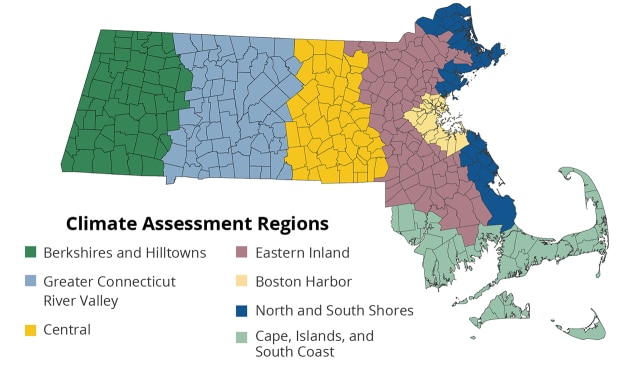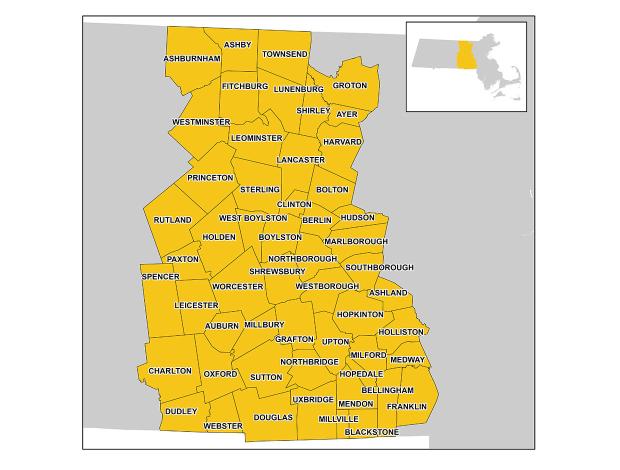Overview
The Commonwealth is already experiencing climate change impacts. Region-specific priorities reflect the unique hazards, natural and built environments, and demographics of each part of the Commonwealth. The Climate Assessment evaluated risks across seven regions:
- Berkshires and Hilltowns Region
- Greater Connecticut River Valley Region
- Central Region
- Eastern Inland Region
- Boston Harbor Region
- North and South Shores Region
- Cape, Islands, and South Coast Region
Volume III of the Climate Assessment includes a summary and full report on each region.
Share These Findings
Share findings about the Central region from the MA Climate Change Assessment with your community through the example social media content below:
Regional Context
The Central region is home to the state’s second most populous city, Worcester, and several other mid-sized municipalities. Block groups with EEA’s environmental justice designation are concentrated in these more urban areas, particularly Worcester, Leominster, and Fitchburg. Though the Central region accounts for nearly 14 percent of the state’s population, it includes only nine percent and 12 percent of the state’s minority and low-income residents, respectively. Regional employment largely tracks state trends, with the healthcare, retail, and manufacturing industries driving much of the regional economy.
The region boundary used for this assessment matches the Municipal Vulnerability Preparedness (MVP) program’s Central region. All 55 municipalities in the region are engaged in climate adaptation planning through the MVP program, with many cities and towns having received further grant money for implementation of resilience projects.
The most important climate hazards for this region include changes to temperature extremes, changes in precipitation patterns, and consequent changes in the patterns of river flows that can lead to inland flooding.
Most Urgent Impacts - Human Sector
Reduction in Food Safety and Security and Health and Cognitive Effects from Extreme Heat are the most urgent Human sector impacts in the Central region, with both projected to produce major magnitudes of consequence. Statewide, the impact of climate change on food security is most acute in rural areas like those that make up much of the Central region. Reduction in crop yields across the state and within the region plays a role in this Statewide and national food supply networks are expected to help compensate for these losses, but those supply chains are increasingly at risk from extreme weather events, and price increases associated with yield declines and supply interruptions could further endanger the region’s food security. Extreme heat impacts also project to be significant, particularly in the Central region’s more urban areas. Heat effects on cognition could further impact learning, productivity, and morbidity outcomes like emergency department visits. Health Effects from Degraded Air Quality, though a top impact statewide, is not a priority concern in this region due to the regional climate. .
Most Urgent Impacts - Infrastructure Sector
In the Infrastructure sector, Loss of Urban Tree Cover and Damage to Electric Transmission and Distribution Infrastructure are the Central region’s most urgent impacts. Climate change is projected to stress urban trees through increased extreme event frequency, increased threat from pests, and reduced water and soil quality, leading to more frequent tree mortality and higher management costs for municipalities. The Central region features a few urban centers, where projected temperature increases make urban tree coverage particularly valuable. In these urban areas and throughout the rest of the region, Damage to Electric Transmission and Distribution Infrastructure is projected to have a major magnitude of consequence The magnitude of consequence estimates consider a wide range of climate stressors and affected infrastructure, and costs are based on the need for repair activities in response to climate-related damage and failure.
Read more about infrastructure sector impacts in the report.
Most Urgent Impacts - Natural Environment Sector
Freshwater Ecosystem Degradation and Forest Health Degradation are both projected to have extreme magnitudes of consequence in the Central region. Climate change threatens freshwater ecosystems through increased nutrient loading and harmful algal bloom growth, increased contaminant concentrations during drought conditions, and shifting habitat regimes as air and water temperatures rise. The region’s coldwater habitats and the fisheries they support are particularly at risk from increased temperatures. The region’s forests are also at risk—though the effects of climate change on forest health are highly uncertain, the scale of transition and potential for lost ecosystem services due to expected climate-caused disturbances is expected to be significant. Statewide, a third of tree species are classified by the U.S. Forest Service as having low capacity for adapting to projected climate changes, and an increased frequency of extreme events poses an additional threat to forests in the Central region.
Read more about natural environment sector impacts in the report.
Most Urgent Impacts - Governance Sector
The Central region’s most urgent Governance sector impacts are Increase in Costs of Responding to Climate Migration and Increase in Demand for State and Municipal Government Services. The consequences of climate migration are difficult to assess, but this impact is classified as having a major magnitude of consequence in the region based on review of existing literature on climate migration prospects and the likelihood that Massachusetts (and particularly urban centers like Worcester) could be a receiving zone for climate migrants based on a relative assessment of climate hazards. Climate migration and other threats are expected to increase demand for government services. The need to increase expenditures to maintain the current level of governmental services represents a potentially important stressor for the local governments of the Central region. For this region there could be increased needs for MassHealth, food security support , and emergency response resulting from climate change. Many of these impacts are expected to be concentrated among those residing in low-income block groups.
Most Urgent Impacts - Economy Sector
Reduced Ability to Work and Decrease in Agricultural Productivity are the Central region’s most urgent Economy sector impacts. Climate change hazards can make it difficult for people to work because of dangerous conditions (i.e., extreme heat), transportation disruptions, and illness. In the Central region, the primary concern for workers in the Economy sector is reduced ability to work during extreme heat. Workers in the region in high-risk industries (those exposed to outdoor conditions) are projected to lose 31 hours per worker each year by 2050 and 128 hours per worker each year by 2090, the highest in the Commonwealth by the end of the century. While agriculture plays a smaller role in the Central region than some other regions, impacts on yields have potentially significant impacts on local economies and regional food systems.
Featured Adaptation Effort
Integrated Vector-Borne Disease Control Program
Looking for alternatives to aerial spraying, the Town of Uxbridge sought funding for local monitoring and biological control of mosquito populations. Working cooperatively across Town Departments, the project also includes designs and permitting for two priority culverts, an update to the Town’s Open Space and Recreation Plan, vernal pool identification/certification and education, and a public education campaign focused on climate change and preventing mosquito-transmitted disease.
Quick links
- ResilientMass Homepage
- ResilientMass Site Map
- Massachusetts Climate Change Assessment
- Massachusetts Climate Change Assessment – Berkshires and Hilltowns Region
- Massachusetts Climate Change Assessment – Greater Connecticut River Valley Region
- Massachusetts Climate Change Assessment – Eastern Inland Region
- Massachusetts Climate Change Assessment – Boston Harbor Region
- Massachusetts Climate Change Assessment – North and South Shores Region
- Massachusetts Climate Change Assessment – Cape, Islands, and South Coast Region
- Massachusetts Climate Change Assessment – Regional Summary Volume III
- Massachusetts Climate Change Assessment – Regional Report Volume III










